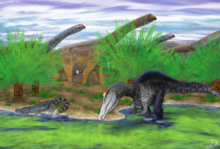Laurasiformes
Stratigrafický výskyt: Spodní křída, asi před 130 až 100 miliony let | |
|---|---|
 Rekonstrukce vzezření rodu Cedarosaurus, zástupce kladu | |
| Vědecká klasifikace | |
| Říše | živočichové (Animalia) |
| Kmen | strunatci (Chordata) |
| Třída | plazi (Sauropsida) |
| Nadřád | dinosauři (Dinosauria) |
| Řád | plazopánví (Saurischia) |
| Infrařád | Sauropoda |
| Nadčeleď | Laurasiformes Royo-Torres, 2009 |
| Některá data mohou pocházet z datové položky. | |
Laurasiformes („formy z Laurasie“; zástupci = laurasiformové) byli středně velcí sauropodní dinosauři, žijící v období rané křídy (věky apt až alb, asi před 130 až 100 miliony let) na území dnešní Severní Ameriky, Jižní Ameriky a Evropy.[1]
Historie
Tento klad stanovil roku 2009 španělský paleontolog Rafael Royo-Torres a definoval jej jako „všechny sauropody vývojově bližší rodu Tastavinsaurus než rodu Saltasaurus.“ Tuto definici splňují rody Aragosaurus, Galvesaurus, Phuwiangosaurus, Venenosaurus, Cedarosaurus, Tehuelchesaurus, Sonorasaurus a Tastavinsaurus.[2]
Zařazení
Klad Laurasiformes náleží do taxonomických skupin Neosauropoda, Macronaria a Camarasauromorpha.[3][4] Podle jiných výzkumů se ale jedná spíše o zástupce kladu Somphospondyli nebo dokonce čeledi Brachiosauridae, novější výzkumy pak existenci tohoto kladu nepodporují.[5]
Odkazy
Reference
- ↑ Upchurch, Paul (1995). "The evolutionary history of sauropod dinosaurs". Phil. Trans. R. Soc. Lond. B., 349 (1330): 365–390. doi:10.1098/rstb.1995.0125
- ↑ Royo-Torres, R. (2009). "Los dinosaurios saurópodos en la Península Ibérica. Actas de las IV Jornadas Internacionales sobre Paleontología de Dinosaurios y su Entorno". Salas de los Infantes, Burgos: 139–166.
- ↑ Royo-Torres, Rafael; Alcalá, Luis; Cobos, Alberto (2012). "A new specimen of the Cretaceous sauropod Tastavinsaurus sanzi from El Castellar (Teruel, Spain), and a phylogenetic analysis of the Laurasiformes". Cretaceous Research. 34: 61–83. doi: 10.1016/j.cretres.2011.10.005
- ↑ Mocho, Pedro; Royo-Torres, Rafael; Ortega, Francisco (2014). "Phylogenetic reassessment of Lourinhasaurus alenquerensis, a basal Macronaria (Sauropoda) from the Upper Jurassic of Portugal". Zoological Journal of the Linnean Society. 170 (4): 875–916. doi:10.1111/zoj.12113.
- ↑ D'Emic, M. D. (2012). "The early evolution of titanosauriform sauropod dinosaurs". Zoological Journal of the Linnean Society. 166 (3): 624–671. doi: 10.1111/j.1096-3642.2012.00853.x
Literatura
- Taylor, M. P.; Naish, D. (2007). An Unusual New Neosauropod Dinosaur from the Lower Cretaceous Hastings Beds Group of East Sussex, England. Palaeontology. 50 (6): 1547–1564. doi: 10.1111/j.1475-4983.2007.00728.x
- Barco, J. L. (2010). Implicaciones filogenéticas y paleobiogeográficas del saurópodo Galvesaurus herreroi Barco, Canudo. Cuenca-Bescós y Ruiz-Omeñaca 2005. V Jornadas Internacionales Sobre Paleontología de Dinosaurios y Su Entorno: 3–6.
- José L. Carballido, Oliver W. M. Rauhut, Diego Pol and Leonardo Salgado (2011). Osteology and phylogenetic relationships of Tehuelchesaurus benitezii (Dinosauria, Sauropoda) from the Upper Jurassic of Patagonia. Zoological Journal of the Linnean Society. 163 (2): 605–662. doi: 10.1111/j.1096-3642.2011.00723.x
Odkazy
- Profil taxonu na webu Fossilworks Archivováno 10. 1. 2021 na Wayback Machine (anglicky)
Média použitá na této stránce
Autor:
- Information-silk.png: Mark James
- derivative work: KSiOM(Talk)
A tiny blue 'i' information icon converted from the Silk icon set at famfamfam.com
Autor: Based on sketch by: Offy, new digital iteration of drawing with more fauna, colour, and amplified detail by: PaleoGeekSquared, Licence: CC BY-SA 4.0
Restoration of the spinosaurid dinosaur Siamosaurus in the Sao Khua Formation palaeoenvironment, with Sunosuchus in the middle left and a herd of Phuwiangosaurus in the background.
- References:
Siamosaurus based on tooth specimens [1] and the neural spine of a possibly referable skeleton[2], with other missing elements filled in with relatives (Suchomimus[3], Baryonyx[4], IchthyovenatorFile:Ichthyovenator_laosensis_skeletal_reconstruction_by_PaleoGeek.png).
Phuwiangosaurus based on skeletal by Suteethorn et al. (2009)[5] and missing elements of skull of EuhelopusFile:Euhelopus.png.
Sunosuchus based on Suteethorn and Ingavat (1983)[6] and missing elements based on Goniopholis[7].


